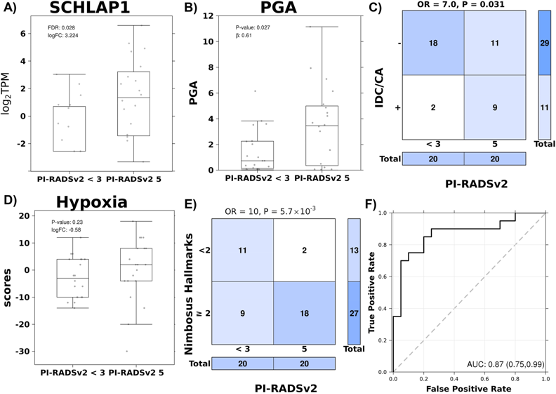In another study from Dr. Reiter’s group published in European Urology in 2019, they identified 20 PI-RADs 5 tumors with a final Gleason score of 3+4 disease and 20 non-visualized tumors with a final Gleason score of 3+4.1 These tumors were matched for tumor size and location, and DNA/RNA were extracted from each tumor. Copy number analysis and RNA sequencing were performed and analyzed. mpMRI-visible tumors had genomes with increased mutation density, a higher prevalence of intraductal carcinoma/cribriform architecture pathology, and altered abundance of 102 transcripts, including overexpression of noncoding RNAs such as SCHLAP1. mpMRI-visible tumors were also enriched in hallmarks of nimbosus, an aggressive pathological, molecular, and microenvironmental phenomenon in prostate cancer.
Multiple small nucleolar RNAs (snoRNAs) were identified, and a snoRNA signature synergized with nimbosus hallmarks to discriminate visible from invisible tumors. Nimbosus is characterized by the co-occurrence of pathological, molecular, and microenvironmental events associated with an aggressive tumor phenotype, including (i) intraductal carcinoma and cribriform architecture, (ii) genomic instability, and (iii) SCHLAP1 expression and hypoxia. Genomic instability is quantified as the percentage of the genome altered via CNAs (PGA):

Dr. Reiter concluded his presentation with the following take-home messages:
- mpMRI has been a game-changing modality for the diagnosis and management of prostate cancer
- mpMRI does not visualize all tumors, particularly secondary and tertiary foci
- PI-RAD score captures both anatomic and functional information
- Grade for grade, higher PI-RAD score is associated with a higher risk of adverse pathology and biochemical recurrence
- Visible tumors are associated with adverse pathologic and genomic features including cribriform/intraductal histology, genomic instability, gene expression signatures, and probably hypoxia
- In other words, “invisible” may not always signify a shortcoming of MRI, but may provide hints about tumor biology above and beyond simple Gleason score
Presented by: Robert Reiter, MD, Professor, Urology, Molecular Biology, Director, Prostate Cancer Program, Director of Urologic Research, Co-Director, Genitourinary Oncology Program, UCLA Jonsson Cancer Center, University of California Los Angeles Medical Center, Los Angeles, California
Written by: Zachary Klaassen, MD, MSc, Assistant Professor of Urology, Georgia Cancer Center, Augusta University/Medical College of Georgia, Augusta, Georgia, Twitter: @zklaassen_md at the 2020 Society of Urologic Oncology Annual Meeting – December 2-5, 2020 – Washington, DC
Reference:
1. Houlahan, Kathleen E., Amirali Salmasi, Taylor Y. Sadun, Aydin Pooli, Ely R. Felker, Julie Livingstone, Vincent Huang et al. "Molecular hallmarks of multiparametric magnetic resonance imaging visibility in prostate cancer." European urology 76, no. 1 (2019): 18-23.


